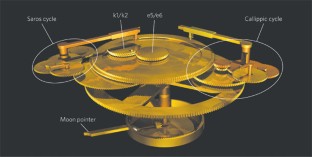High tech from Ancient Greece (original) (raw)
- News & Views
- Published: 01 November 2006
Archaeology
Nature volume 444, pages 551–552 (2006)Cite this article
- 2753 Accesses
- 5 Altmetric
- Metrics details
A Correction to this article was published on 06 December 2006
The Antikythera Mechanism, salvaged 100 years ago from an ancient shipwreck, was long known to be some sort of mechanical calendar. But modern analysis is only now revealing just how sophisticated it was.
This is a preview of subscription content, access via your institution
Access options
Subscribe to this journal
Receive 51 print issues and online access
$199.00 per year
only $3.90 per issue
Buy this article
- Purchase on SpringerLink
- Instant access to full article PDF
Prices may be subject to local taxes which are calculated during checkout
Additional access options:
Figure 1: Wheels within wheels.

Figure 2: Islamic descendant.

UNIV. LIBRARY, LEIDEN
References
- Freeth, T. et al. Nature 444, 587–591 (2006).
Article ADS CAS Google Scholar - Price, D. de S. Trans. Am. Phil. Soc. 64(7), 1–70 (1974).
Article Google Scholar - Price, D. de S. Science Since Babylon 48 (Yale Univ. Press, 1975).
Google Scholar - Wright, M. T. in Proc. 2nd Int. Conf. Ancient Greek Technol. (ed. Tassios, Th.) 49–60 (Technical Chamber of Greece, Athens, 2006).
Google Scholar - Wright, M. & Fields, J. Ann. Sci. 42, 87–138 (1985).
Article MathSciNet Google Scholar - Hill, D. Ann. Sci. 42, 139–163 (1985).
Article MathSciNet Google Scholar
Author information
Authors and Affiliations
- François Charette is at the Lehrstuhl für Geschichte der Naturwissenschaften, Ludwig-Maximilians-Universität, Museumsinsel 1, München, D-80538, Germany
François Charette
Authors
- François Charette
You can also search for this author inPubMed Google Scholar
Rights and permissions
About this article
Cite this article
Charette, F. High tech from Ancient Greece.Nature 444, 551–552 (2006). https://doi.org/10.1038/444551a
- Published: 01 November 2006
- Issue Date: 30 November 2006
- DOI: https://doi.org/10.1038/444551a